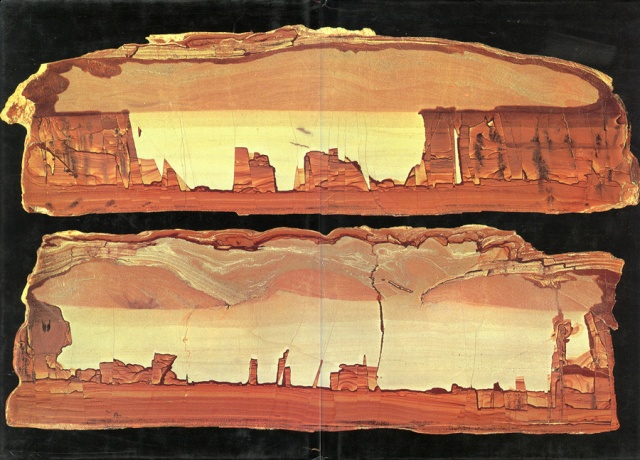Venetia Porter: Word Into Art: Artists of the Modern Middle East (2006)
Filed under catalogue | Tags: · africa, art, art history, calligraphy, ceramics, contemporary art, hurufiyya, islam, language, literature, middle east, painting

This landmark catalogue is one of “the most comprehensive gatherings of Middle Eastern artists that has been undertaken in recent times.” Based on an exhibition mounted by the British Museum, it is “devoted to the recurring theme of calligraphy and how artists from the Middle East and North Africa use the traditional visual vocabulary of Arabic letters as a point of departure and an integral expressive element. The works, which were drawn mostly from the British Museum’s own collection of contemporary Islamic art, demonstrate how each artist celebrates the aesthetic powers and plasticity of the letters, while simultaneously pushing the boundaries, even sometimes subverting traditional canons. The artists manipulate letters, often transforming them beyond recognition, using ingenious and innovative methods, materials, styles, and daring compositions. Some use letters for purely aesthetic reasons, while others use them more instrumentally as writing, signs, or ciphers that allow the artists to grapple with issues of socio-political orientation and cultural and religious identity. For some artists this resonates with the sacred tradition of Islam and the Qur’an, while for others it is an undeniable part of their cultural heritage and a natural vehicle for expression.” (Sourced from the two reviews linked below.)
Foreword by Saeb Eigner
With contributions by Isabelle Caussé
Publisher British Museum Press, London, 2006
ISBN 0714111635, 9780714111636
144 pages
via IslamicManuscripts.info
Reviews: Islamic Monthly (2006), Maryam Ekhtiar (CAA Reviews 2007).
PDF (124 MB)
Comment (0)Shamil Jeppie, Souleymane Bachir Diagne (eds.): The Meanings of Timbuktu (2008)
Filed under book | Tags: · africa, book, calligraphy, education, history of literature, islam, library, literature, paper

In a joint project between South Africa and Mali, a library to preserve more than 200 000 Arabic and West African manuscripts dating from the 13th to the 19th centuries is currently under construction. It is the first official cultural project of the New Partnership for Africa’s Development (Nepad), the socio-economic development plan of the African Union, and when the library is built, the cultural role of Timbuktu will be revived, as it becomes the safehaven for the treasured manuscripts. The manuscripts prove that Africa had a rich legacy of written history, long before western colonisers set foot on the continent.
This volume, authored by leading international scholars, begins to sketch the ‘meaning’ of Timbuktu within the context of the intellectual history of West Africa, in particular, and of the African continent, in general. The book covers four broad areas: Part I provides an introduction to the region; outlines what archaeology can tell us of its history, examines the paper and various calligraphic styles used in the manuscripts; and explains how ancient institutions of scholarship functioned. Part II begins to analyse what the manuscripts can tell us of African history. Part III offers insight into the lives and works of just a few of the many scholars who achieved renown in the region and beyond. Part IV provides a glimpse into Timbuktu’s libraries and private collections. Part V looks at the written legacy of the eastern half of Africa, which like that of the western region, is often ignored.
A fascinating read for anyone who wishes to gain an understanding of the aura of mystique and legend that surrounds Timbuktu. The Meanings of Timbuktu strives to contextualize and clarify the importance of efforts to preserve Timbuktu’s manuscripts for Mali, for Africa and for the intellectual world.
Publisher HSRC, Cape Town, in association with CODESRIA, Dakar, 2008
Open Access
ISBN 0796922047, 139780796922045
416 pages
Review (David Robinson, H-SAfrica, 2009)
Publisher (HSRC)
Publisher (CODESRIA)
PDF (single PDF)
PDF (PDF chapters)
Roger Caillois: The Writing of Stones (1970/1985)
Filed under book | Tags: · calligraphy, geology, mineralogy, writing

“The Writing of Stones is a fascinating meditation on the human imagination contemplating the interior of stones. Caillois examines patterns that are revealed by polishing sections of minerals such as agate, jasper, and onyx. He considers the impact these configurations have had upon the human imagination throughout history and he reviews man’s attempt to categorize and explain them.
Marguerite Yourcenar [in her introduction] points out that ‘there had taken place in [his] intellect the equivalent of the Copernican revolution: man was no longer the center of the universe, except in the sense that the center is everywhere; man, like all the rest, was a cog in the whole system of turning wheels. Quite early on, having entered ‘the forbidden laboratories,’ Caillois applied himself to the study of diagonals which link the species, of the recurrent phenomena that act, so to speak as a matrix of forms.’ Caillois found the presence throughout the universe of a sensibility and a consciousness analogous to our own. One way which this consciousness expresses itself is in a “natural fantasy” that is evident in the pictures found in stones. Man’s own aesthetic may then be no more than one of many manifestations of an all-pervasive aesthetic that reveals itself in the natural world.”
First published as L’ecriture des pierres, Editions d’Art Albert Skira, Genève, 1970
Translated by Barbara Bray
With an Introduction by Marguerite Yourcenar
Publisher University Press of Virginia, Charlotesville, 1985
ISBN 0813910501, 9780813910505
108 pages
via pink panter
Commentaries: Marina Warner (Cabinet), 50 Watts.
Interview with author (video, 26 min, 1974, ina.fr, in French, via Véfa Lucas)
PDF (5 MB, updated on 2020-11-19)
Comments (5)
